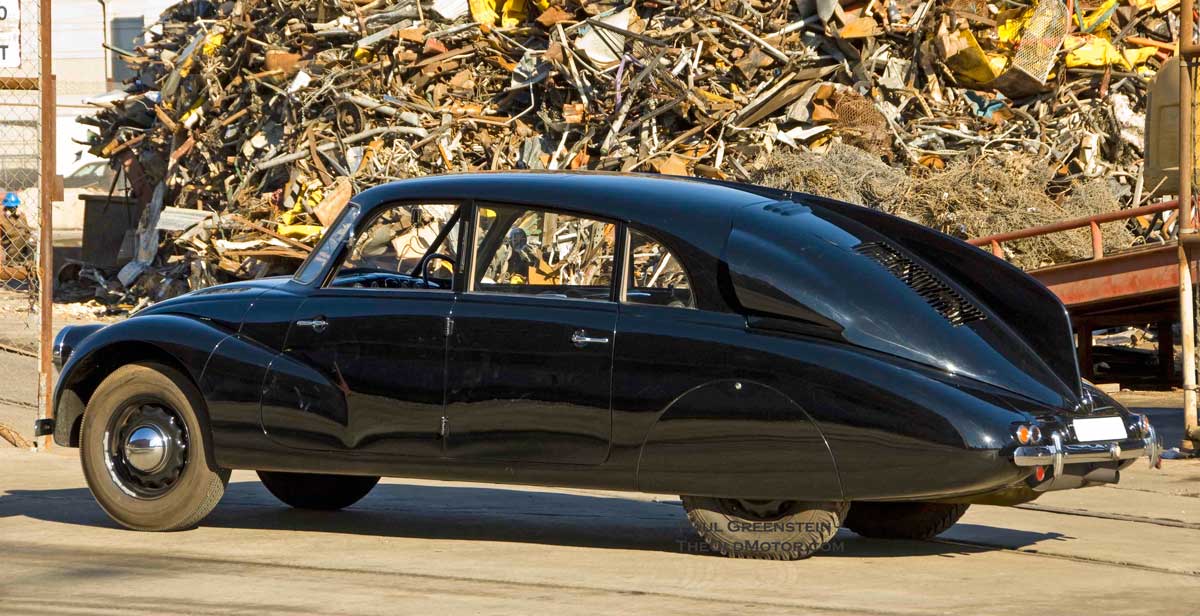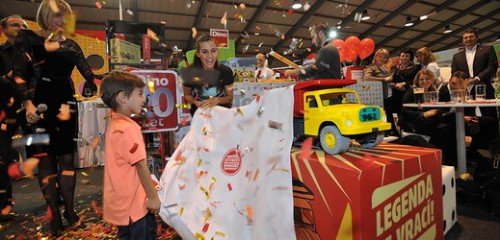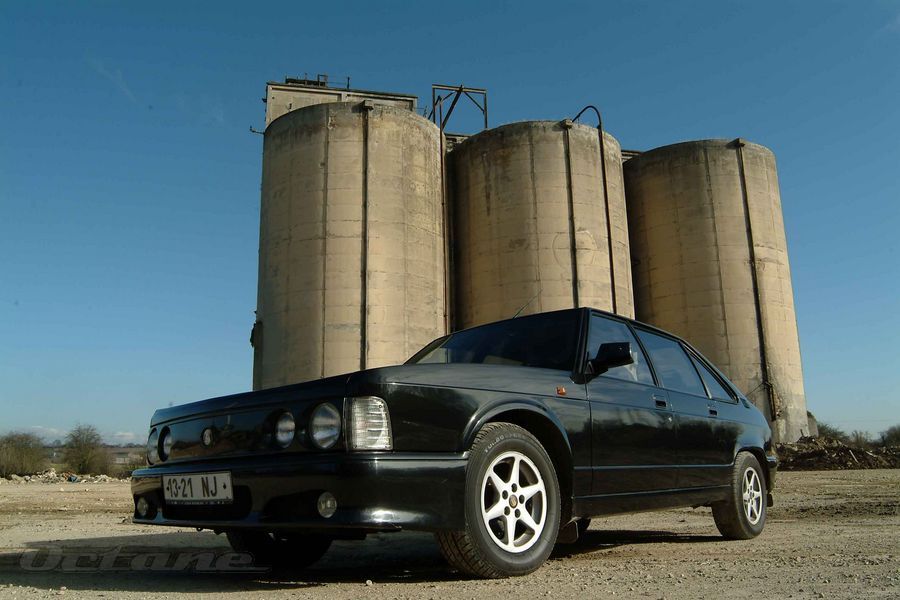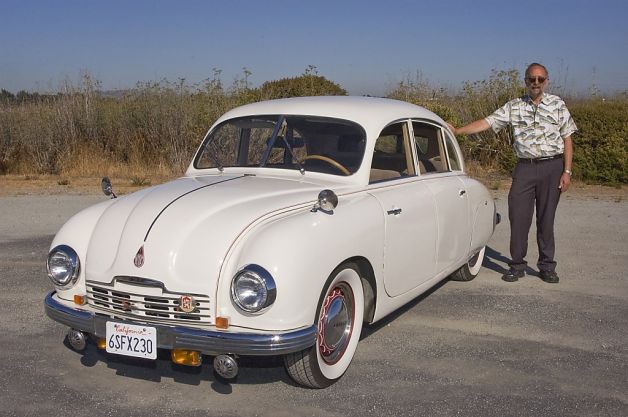
Tatra 77 meant for Kopřivnice pioneering. It became the first mass-produced aerodynamic car world and just celebrated his eightieth. The topic we return promised a longer article.
“Sedmasedmdesátka” caused when the official release of a sensation. For the first time the masterpiece for which they stood and Hans Erich and Erich Ledwinka Übelacker, presented at the Motor Show in Prague 5 března, 1934. The third man was appointed in charge of the shapes, the first two techniques. Soon thereafter, even during the same month, he began to produce elegant car. About some large-scale production can not be described, but the prototype phase was successfully overcome. Tatra Moreover glory in this respect, first in the world, though it claims several other manufacturers, such as American Chrysler Airflow model. Aerodynamic experiments that were previously. Think of the most famous: drop shaped Alfa 40/60 HP from the body shop Castagna for Count Ricottiho (1914), Tropfenwagen Edmund Rumpler, or the work of Romanian Aurel PERS .
Test T77 prototype, which was built probably six, he ran the year before. Differed mount the door , but also the shape of the stern, they just ribbing on the sides of the cover instead of the standard powerplant with mud and smaller šestnáctipalcová wheels. First got swept divided by (a dump!) Windshield. Experiments were carried out with the sinking of the headlamps, the two pieces were completely embedded in the body. The third prototype with a wheel in the middle of the windshield approaching production-version was issued in 1933 in the pre-premiere in Berlin.
Beauty with rear engine
Type 77 has retained the traditional concept automakers are air-cooled engine and rear swinging half-axles. The front wheels were independently suspended trapezoidal arms, suspension always catered to a broad cross půleliptické single leaf spring. Center back bifurcated beam carrying power unit. Four-stroke petrol engines V8 OHC had a volume of 2969 cm 3 (75 bore, 84 mm stroke). With a compression ratio 5,3:1 reached output of 44 kW at 3500 rpm. He was, however, right at the back of the driven axle. The renegade and use of a central pipe exhaust manifold and complex. The crankcase was cast in the electron fuel supplied double carburetor Zenith 36 DV1. Pressure circulation lubrication worked with sedmilitrovou oil bath at 100 km was needed about 0.4 liters of lubricant. Strictly streamlined aerodynamic body with a coefficient of drag of 0.36 for the first time in the history of Tatra-metal and semi-self to vždřevu relied solely first pieces, Luxury limousine to a six-figure measured in length 5130 mm, 1700 mm was wide and 1500 mm high. “Dress” knowledge created by Swiss Hungarian origin Paula Jaraye and tested in a wind tunnel, which was then used only for testing airships and airplanes. Headlights performed the bodywork, windscreen was then only three parts.
Chassis with a wheelbase of 3150 mm, a gauge of 1300 mm and a wheel for today’s high ground clearance 220 mm could therefore be very flat and weight smaller cars weigh 1700 kg. Functional constituted a large part of the fin flowing aft, who cared for stability in a crosswind. Thanks to the advanced shapes that time the car reached the osmnáctipalcových rounds to 145 km / h, this rate was additionally seamlessly sustainable. Deceleration assisted liquid drum brakes on all wheels, parking worked on the back. Travel gasoline consumption ranged between 14 and 16 l/100 km. Heavier competition to achieve the speed needed about one-third more power … The torque transfer through the dry single plate clutch Komet Mecano look after four-speed automatic, the latter two should sync speed. Bosch Ignition and electrical installations were dvanáctivoltové, the battery was located along the margin in front of the car.
In the press presentation in March 1934, type 77 chasing after Carlsbad road. Handling and driving characteristics including cornering behavior was at that time a remarkable car apparently great fit. Thanks to the concept inherent oversteer, however, he has not denied Journalists praised and above average comfort and low noise at speeds above 100 km / h International Paris premiere took place in the fall of that season, where the car raised considerable commotion among the heads of American corporations and techniques of the British Rolls-Royce not only with futuristic shapes. They would not believe that despite so little power the engine is capable of flirting with a hundred and fifty “Sedmasedmdesátka” the common automotive production simply beggared, although its acceleration was tepid.
Longer and stronger
Your car even good battle, appropriately modified specimen graduated in 1934 race season 1000 miles Czechoslovak! Do the following (1935) was made of Type 101 T 77 Evolution proceeded, type 77a of the second series (1936-1938). The improved model powered overworked bulkier osmiválec 3378 cm 3 with a larger 88 mm bore and higher compression ratio of 6:1. Power indicated in the range of 51-55 kW was available at the same speed as its predecessor, but the engine had already two oil coolers. Transmission remained the same. 77a was while still a 5 km / h faster, even though her weight increased to equal 1.8 tons. From the original model differed also a third, centrally located front lamp, though it also had some cars from the end of the first series. The wheelbase increased by 100 mm to 3250 mm and thanks to improved driveability, not only at high speeds. The length is also dramatically increased to 5410 mm. Drag coefficient dropped to 0.21 captivating, this value was not measured on a real car, but a miniature. Fuel consumption has not changed.
“A’s” produced a total of 154 units, total production without the prototypes and reached only 255 copies. Lots of great interest represented the only two-door piece just type 77a, with whom rode alone designer Erich Übelacker, all other “sedmasedmdesátky” the four-door. Given that virtually built manually, perhaps no car was not the same, at least all the details differ. The surviving pieces undoubtedly the most notable contribution to the world of domestic automotive history are now virtually unavailable goods. Prague NTM own silver car Mr. Radim marc from 1937, which was involved in the construction of this building. It is about 180 mm wider than the other and has a greater inclination of the windscreen. Kopřivnické factory museum exhibits turn blue car without front bumper and air trap on the sides of the engine cover type 87 but not original. The Type 77 was followed by 87 with fork osmiválcem 2.97 l/55 kW, the first pieces were created in parallel, smaller post-war Tatraplan 600 (four-cylinder 1952 cm 3 / 38 kW) and 603 representative She returned to the V8 engine with dvouapůllitrovým volume, first 2545 cm 3 , then 2472 cm 3 .
Models
Come into their own at least collectors automobile models, recently appeared miniatures from Ixo: black, burgundy in the series Altaya and bronze, which he produced in a limited edition of the Prague firm Fox Toys . It is currently on sale silver model of a White Box also offers Prague MAC Model 77 type resin produced in different versions. Always a 1:43 scale. Prices range from 500 to approximately 1,500 Crowns apiece.
Tatra 77 meant for Kopřivnice pioneering. It became the first mass-produced aerodynamic car world and just celebrated his eightieth. The topic we return promised a longer article.
“Sedmasedmdesátka” caused when the official release of a sensation. For the first time the masterpiece for which they stood and Hans Erich and Erich Ledwinka Übelacker, presented at the Motor Show in Prague 5 března, 1934. The third man was appointed in charge of the shapes, the first two techniques. Soon thereafter, even during the same month, he began to produce elegant car. About some large-scale production can not be described, but the prototype phase was successfully overcome. Tatra Moreover glory in this respect, first in the world, though it claims several other manufacturers, such as American Chrysler Airflow model. Aerodynamic experiments that were previously. Think of the most famous: drop shaped Alfa 40/60 HP from the body shop Castagna for Count Ricottiho (1914), Tropfenwagen Edmund Rumpler, or the work of Romanian Aurel PERS .
Test T77 prototype, which was built probably six, he ran the year before. Differed mount the door , but also the shape of the stern, they just ribbing on the sides of the cover instead of the standard powerplant with mud and smaller šestnáctipalcová wheels. First got swept divided by (a dump!) Windshield. Experiments were carried out with the sinking of the headlamps, the two pieces were completely embedded in the body. The third prototype with a wheel in the middle of the windshield approaching production-version was issued in 1933 in the pre-premiere in Berlin.
Beauty with rear engine
Type 77 has retained the traditional concept automakers are air-cooled engine and rear swinging half-axles. The front wheels were independently suspended trapezoidal arms, suspension always catered to a broad cross půleliptické single leaf spring. Center back bifurcated beam carrying power unit. Four-stroke petrol engines V8 OHC had a volume of 2969 cm 3 (75 bore, 84 mm stroke). With a compression ratio 5,3:1 reached output of 44 kW at 3500 rpm. He was, however, right at the back of the driven axle. The renegade and use of a central pipe exhaust manifold and complex. The crankcase was cast in the electron fuel supplied double carburetor Zenith 36 DV1. Pressure circulation lubrication worked with sedmilitrovou oil bath at 100 km was needed about 0.4 liters of lubricant. Strictly streamlined aerodynamic body with a coefficient of drag of 0.36 for the first time in the history of Tatra-metal and semi-self to vždřevu relied solely first pieces, Luxury limousine to a six-figure measured in length 5130 mm, 1700 mm was wide and 1500 mm high. “Dress” knowledge created by Swiss Hungarian origin Paula Jaraye and tested in a wind tunnel, which was then used only for testing airships and airplanes. Headlights performed the bodywork, windscreen was then only three parts.
Chassis with a wheelbase of 3150 mm, a gauge of 1300 mm and a wheel for today’s high ground clearance 220 mm could therefore be very flat and weight smaller cars weigh 1700 kg. Functional constituted a large part of the fin flowing aft, who cared for stability in a crosswind. Thanks to the advanced shapes that time the car reached the osmnáctipalcových rounds to 145 km / h, this rate was additionally seamlessly sustainable. Deceleration assisted liquid drum brakes on all wheels, parking worked on the back. Travel gasoline consumption ranged between 14 and 16 l/100 km. Heavier competition to achieve the speed needed about one-third more power … The torque transfer through the dry single plate clutch Komet Mecano look after four-speed automatic, the latter two should sync speed. Bosch Ignition and electrical installations were dvanáctivoltové, the battery was located along the margin in front of the car.
In the press presentation in March 1934, type 77 chasing after Carlsbad road. Handling and driving characteristics including cornering behavior was at that time a remarkable car apparently great fit. Thanks to the concept inherent oversteer, however, he has not denied Journalists praised and above average comfort and low noise at speeds above 100 km / h International Paris premiere took place in the fall of that season, where the car raised considerable commotion among the heads of American corporations and techniques of the British Rolls-Royce not only with futuristic shapes. They would not believe that despite so little power the engine is capable of flirting with a hundred and fifty “Sedmasedmdesátka” the common automotive production simply beggared, although its acceleration was tepid.
Longer and stronger
Your car even good battle, appropriately modified specimen graduated in 1934 race season 1000 miles Czechoslovak! Do the following (1935) was made of Type 101 T 77 Evolution proceeded, type 77a of the second series (1936-1938). The improved model powered overworked bulkier osmiválec 3378 cm 3 with a larger 88 mm bore and higher compression ratio of 6:1. Power indicated in the range of 51-55 kW was available at the same speed as its predecessor, but the engine had already two oil coolers. Transmission remained the same. 77a was while still a 5 km / h faster, even though her weight increased to equal 1.8 tons. From the original model differed also a third, centrally located front lamp, though it also had some cars from the end of the first series. The wheelbase increased by 100 mm to 3250 mm and thanks to improved driveability, not only at high speeds. The length is also dramatically increased to 5410 mm. Drag coefficient dropped to 0.21 captivating, this value was not measured on a real car, but a miniature. Fuel consumption has not changed.
“A’s” produced a total of 154 units, total production without the prototypes and reached only 255 copies. Lots of great interest represented the only two-door piece just type 77a, with whom rode alone designer Erich Übelacker, all other “sedmasedmdesátky” the four-door. Given that virtually built manually, perhaps no car was not the same, at least all the details differ. The surviving pieces undoubtedly the most notable contribution to the world of domestic automotive history are now virtually unavailable goods. Prague NTM own silver car Mr. Radim marc from 1937, which was involved in the construction of this building. It is about 180 mm wider than the other and has a greater inclination of the windscreen. Kopřivnické factory museum exhibits turn blue car without front bumper and air trap on the sides of the engine cover type 87 but not original. The Type 77 was followed by 87 with fork osmiválcem 2.97 l/55 kW, the first pieces were created in parallel, smaller post-war Tatraplan 600 (four-cylinder 1952 cm 3 / 38 kW) and 603 representative She returned to the V8 engine with dvouapůllitrovým volume, first 2545 cm 3 , then 2472 cm 3 .
Models
Come into their own at least collectors automobile models, recently appeared miniatures from Ixo: black, burgundy in the series Altaya and bronze, which he produced in a limited edition of the Prague firm Fox Toys . It is currently on sale silver model of a White Box also offers Prague MAC Model 77 type resin produced in different versions. Always a 1:43 scale. Prices range from 500 to approximately 1,500 Crowns apiece.
Serge Bruynkens had expected more of this Dakar is an understatement . On the stage win from a few days ago after driving from Antwerp from frustration to frustration culminating in the penultimate stage in which he finished in 34th place . In the position he lost two places and drops from 4 to 6 .
” We started well on the ride to the air pressure suddenly fell away ,” Bruynkens begins his story . ” The mechanic was trying to solve an emergency repair the problem, but that did not help. Up to four times we have the same problem to stop until I finally got involved with it and the problem got solved . Finally Meanwhile insulted my Czech team mates shit together. I can only conclude that they have no insight and insufficiently prepared at the start of this race have come . Loprais In the dunes once did only his own sense which we 3km from the finish lacked a connection to the touching . dunes he did not do that . I served him answer that he must learn to listen . Moreover, I make no more words to dirt . We lost a stupid way of time today. , I came to the podium and is now finally gone. For me this is a big disappointment , but also associated with the sport. I remain professional and ‘m going to prepare myself for the final stage . “
After stage 12:
Serge Bruynkens had expected more of this Dakar is an understatement . On the stage win from a few days ago after driving from Antwerp from frustration to frustration culminating in stage in12 which he finished in 34th place . In the position he lost two places overall and drops from 4 to 6 .
” We started well on the ride to the air pressure suddenly fell away ,” Bruynkens begins his story . ” The mechanic was trying to solve an emergency repair the problem, but that did not help. Up to four times we had the same problem to stop until I finally got involved with it and the problem got solved . Meanwhile insulted my Czech team mates shit together. I can only conclude that they have no insight and insufficiently prepared at the start of this race have come . Loprais In the dunes once did only his own sense which we 3km from the finish lacked a connection to the touching . dunes he did not do that . I served him answer that he must learn to listen . Moreover, I make no more words to dirt . We lost a stupid way of time today. , I came to the podium and is now finally gone. For me this is a big disappointment , but also associated with the sport. I remain professional and ‘m going to prepare myself for the final stage . “
After Stage 13:

“It was frustrating for me, Dakar, we are still pretty close. Today, we are starting 82nd. For fear of losing our sixth place at Stacey, we are with the knife between the teeth left with the stage win as a result. Most participants were passing us quickly but some kept us some mileage on ” told the Antwerp citizen.
“I am satisfied that I may end up with a stage win, but there had been a lot more if my driver had not been Loprais. Headstrong as He is an excellent driver with a lot of qualities, but unfortunately he is too stubborn. We are a team and you have to do everything together. If you find that you are not listened to, that’s disappointing. Especially if it subsequently appears that you were right. Next year I come back to the Dakar, but not with this team. I’m already on the plane to Belgium. “
http://www.nieuwsblad.be/sportwereld/cnt/dmf20140118_00935590

Paul Greenstein, who owns this 1941 Tatra T87 he found in upstate New York in 2001, happened upon an earlier post and photo here titled: A Tatra in New York City. He believes that there is a good possibility the car he and his girlfriend Dydia Delyser now own may in fact be the same car pictured in New York City at J.P. Inskip’s dealership on October 2, 1948. If any of our readers can help connect the dots between the car at Inskip’s in New York City and this car when it was traded in at Binghamton, New York, please do let us know. Paul relates the story of the unique story as follows: “The car was purchased from the factory at the end of May, 1941 by a car dealer-auto shop owner by the name of Vaclav Konstantin in the Moravian town of Olomouc. He ordered several of the cars and picked them up on consecutive weeks, probably for his customers. The next known whereabouts of the car was in Binghamton, NY around 1950 when it threw a rod and was traded in at Molyneux Lincoln Mercury. It sat on the lot as a wild and wooly come on, until sometime in the mid-sixties, when it was purchased and the restoration was started. The engine was rebuilt and replaced, but none of the cosmetics had been done, when the car came up for sale again”.
Full story: http://theoldmotor.com/









 “It was frustrating for me, Dakar, we are still pretty close. Today, we are starting 82nd. For fear of losing our sixth place at Stacey, we are with the knife between the teeth left with the stage win as a result. Most participants were passing us quickly but some kept us some mileage on ” told the Antwerp citizen.
“It was frustrating for me, Dakar, we are still pretty close. Today, we are starting 82nd. For fear of losing our sixth place at Stacey, we are with the knife between the teeth left with the stage win as a result. Most participants were passing us quickly but some kept us some mileage on ” told the Antwerp citizen.
 The company presented the Dino Toys at Toy Fair Toys and Games For 2013 Letňanech large plastic truck Tatra, with which the Company intends to conquer the playground. Orange Tatra 148 model was one of the indispensable components sandboxes eighties of the last century due to its robustness served not only rides on the sand, but also the children themselves.
The company presented the Dino Toys at Toy Fair Toys and Games For 2013 Letňanech large plastic truck Tatra, with which the Company intends to conquer the playground. Orange Tatra 148 model was one of the indispensable components sandboxes eighties of the last century due to its robustness served not only rides on the sand, but also the children themselves.
